Category: Success Story
Automotive technology program bridges skills with industry demands
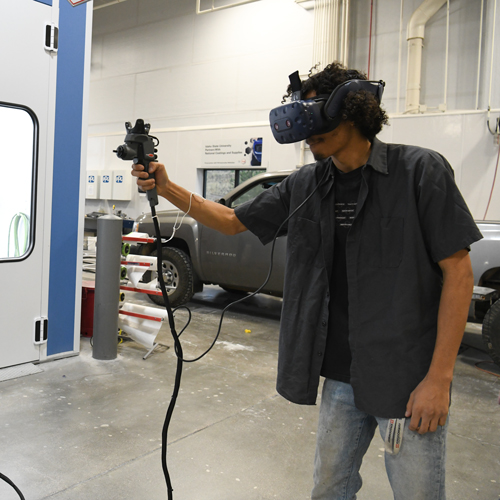
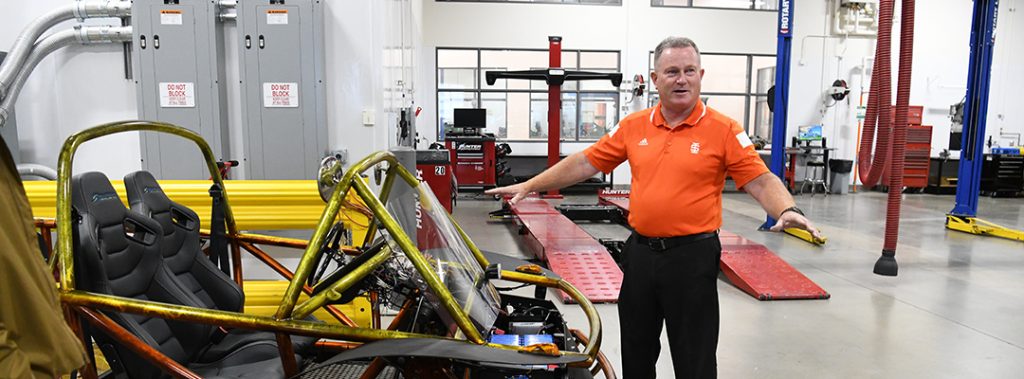
Seeing former students return and witnessing their career growth in the industry after five or 10 years, is truly satisfying.
Brock gunter
Growing up on a farm in Marsh Valley, Brock Gunter’s curiosity drove him to tinker endlessly.
“I took auto all four years of high school,” said Gunter. “My favorite classes were where I got to see how things worked and tear them apart.”
That passion led Gunter to the College of Southern Idaho, where he earned a certificate in diesel technology. For 13 years, he worked in the service department of a Pocatello car dealership. Though he loved his work, a personal connection with Dave Treasure, chair of Idaho State University College of Technology’s transportation department, changed the course of his career.
“They needed an automotive technology instructor, and it felt like a perfect fit,” said Gunter. “Eighteen years later, it still is.”
Gunter’s curriculum, accredited by Automotive Service Excellence (ASE), primes students in engine repair, transmissions, steering, brakes, electrical systems, HVAC, and engine performance. He attributes the program’s success and high job placement rates to plenty of hands-on learning opportunities.
“The last eight weeks of the program, our students focus on what we call live work,” said Gunter. “Some of them work on the cars we have in the shop, and others work in a shop in the community.”
Gunter leans on connections with his technical advisory committee (TAC) to help students find internships and job opportunities. Comprised of representatives from local dealerships and independent shop owners, their insights help Gunter align his teaching methods with industry demands, leading to program enhancements and equipment upgrades. Recent feedback from the committee led Gunter to request new diagnostic equipment and electrical trainers using funds from Governor Little’s Leading Idaho initiative. But it’s not just the hands-on learning opportunities, state-of-the-art equipment, and active and engaged TAC that draw students to Gunter’s program.
“ISU is kind of unique in that, in addition to technical certificates, students can earn an associate’s degree in two years by completing general education requirements,” explained Gunter. “There’s also a path to a four-year Bachelor of Science degree, which draws a lot of students from out-of-state.”
Gunter’s program also attracts interest from area high schools by offering dual credit.
“So I have about 10 students from all three high schools come up here for the last two hours of the day,” said Gunter. “They get the whole first semester done while still in high school, saving them time and money if they choose to continue the program after graduation.”
Regardless of where they come from or where they end up, Gunter takes immense pride in witnessing his students succeed. “Seeing former students return and witnessing their career growth in the industry after five or 10 years, is truly satisfying,” said Gunter.
Cybersecurity program leads the charge to meet growing workforce need
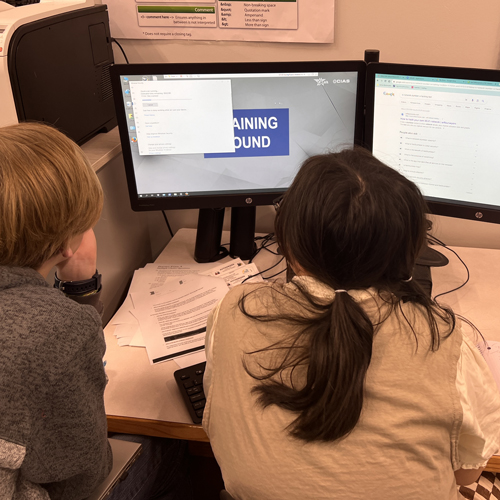

Just four years after its inception, the cybersecurity program at Idaho Falls School District No. 91’s Career Technical Education Center is already impacting the growing need for cybersecurity professionals. According to the Idaho Department of Labor, cybersecurity job openings in Idaho have increased 160% since 2015.
“Because the Idaho National Laboratory (INL) is in our backyard, it seems like they never have enough people to fill all the jobs they have in cybersecurity,” said Cathy Owen, who teaches the district’s cybersecurity classes.
Fortunately, the constant need for employees has translated into a steady stream of support for Owen’s program.
“The INL’s Cyber Corehas been phenomenal from the start,” said Owen. “They’ve provided everything from paid internships to equipment to mentors.”
In fact, some of Owen’s students discovered her program through the College of Eastern Idaho (CEI) and INL’s Cyber Core Summer Camp, which introduces freshmen thruough senior high school students and CTE teachers to cybersecurity and related topics. Students participate in hands-on learning activities, hear from industry mentors, and tour industrial facilities. The weeklong beginner course was held in Idaho Falls, Twin Falls, Boise, and Lewiston last summer, with an advanced course being held exclusively in Idaho Falls.
Through this program, Owen was introduced to Dr. Michael Haney, an assistant professor of computer science at the University of Idaho and a cybersecurity researcher at the INL. Haney, who serves on Owen’s technical advisory committee, has been instrumental in procuring resources Owen needs, like access to equipment, and use of the RADCIL Lab so students can work in a virtual network environment used for teaching cybersecurity without impacting school networks. Haney also introduced Mrs. Owen to the range and helped her secure a spot with cyber.org and their range, which is very important so students can work in a virtual environment.
It allows students to practice security techniques in a controlled, simulated space, offering hands-on experience without jeopardizing actual system. The range allows me to facilitate basic security practices to advanced threat detection in a safe, virtual environment.
Cathy owen
The summer camp has also facilitated partnerships with CEI, which offers dual credit opportunities for Owen’s students and paved the way for Security+ certification, an industry-recognized validation of foundational cybersecurity expertise.
Beyond academics, students benefit from participation in four content-related clubs, including the Cyber Patriot Program, Cyber Start America, Business Professionals of America, and, Idaho’s first high school chapter of Women in Cyber Security. These clubs foster practical application of the skills students learn in class and further their knowledge of cybersecurity.
The support and resources her students have access to have led to many promising opportunities in this growing field.
“I love hearing from my former students and having them share their experiences,” said Owen. “One of them received a full-time position at INL’s Help Desk; they’re actually earning a decent wage and getting their college experience paid.”
Digital media production program shapes future leaders in broadcasting

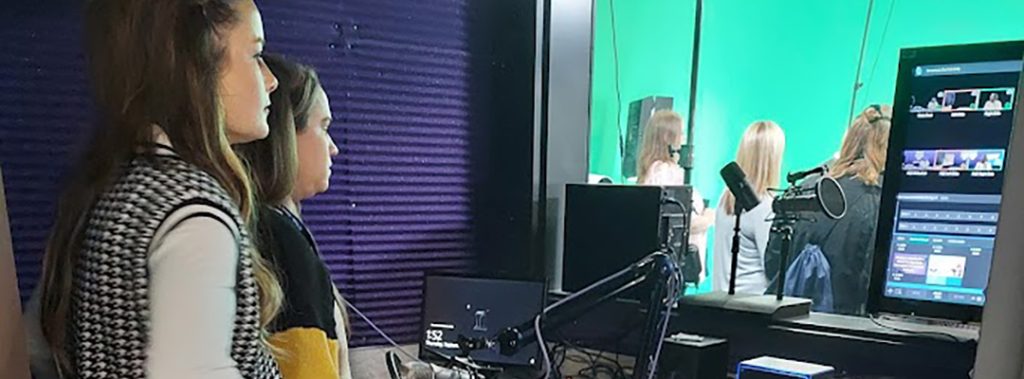
Davey Steele was always an athlete, so it was a natural fit when he got a work-study job running the video board, replay system, and shot clock for Vandal games at the University of Idaho’s Kibby Dome.
After he graduated with a degree in advertising in 2012 and had trouble finding a job, he started teaching economics, business, and merchandising at Lewiston High School (LHS). Before long, Steele found himself in a familiar spot: running the scoreboard, video board, and shot clocks at LHS’s basketball games. One night, Steele struggled to run all the equipment, plus play music during time outs on his own.
“It was absolutely crazy, and I needed help,” Steele recalls. “At some point, I thought, ‘I could teach my students to do this.’” Steele approached his principal about teaching the kids video production so they could help run games, and with his support, Steele started a sports broadcasting class as part of the school’s digital media production pathway.
Soon after, Steele requisitioned some lighting and a Tricaster production system for doing live video and graphics, and students started going live on YouTube with their school announcements every morning. This initial investment in equipment allowed the sports broadcasting students to stream the 2022 Golden Throne basketball game, an annual charity event held at Lewis-Clark State College. Their high-quality production received an incredible number of views on YouTube. Steele and his students were so excited they started live-streaming all of LHS’s basketball games.
“Games would end around nine or 9:30 p.m., and we’d have to wheel everything back to the studio to record the daily announcement the next morning. I didn’t like the wear and tear on the equipment,” said Steele.
Then, one of Steele’s students told him about a school in Mississippi with a mobile TV studio in a semi-truck. Steele had heard about Governor Little’s Leading Idaho grant program, so he wrote a grant for $104,000 to create LHS’s own mobile TV studio, complete with a trailer, replay system, monitors, Tricaster, and 300-foot cables.
With the mobile studio, we’ll be able to live stream our games on YouTube, and I believe we’re in a position to get enough views that we can sell ads.
Davey Steele
But Steele’s students’ ambition extends far beyond the studio. As LHS’s BPA, yearbook, and Associated Student Body advisor, Steele also encourages his students to flex their entrepreneurial muscles. One of his students took pictures at school dances and sold flash drives of the unedited images for $20; she raised $1,000 in a single night. Another student developed a marketing plan for the athletic department and used the school’s large-format Epson printer to print banners on sticky vinyl and windscreens to hang in the gym and outdoor facilities. They were sold to local businesses, and she raised $80,000 in a year.
Steele’s innovation and entrepreneurial drive were among the many factors that led to his program receiving an honorable mention in IDCTE’s 2023 Exemplary Program Awards. “We’re well on our way to being self-supported,” said Steele. “I say all this because I hope schools across Idaho can see what we’ve done here and be inspired to do the same.”
Grant transforms Bonners Ferry High School woodworking program

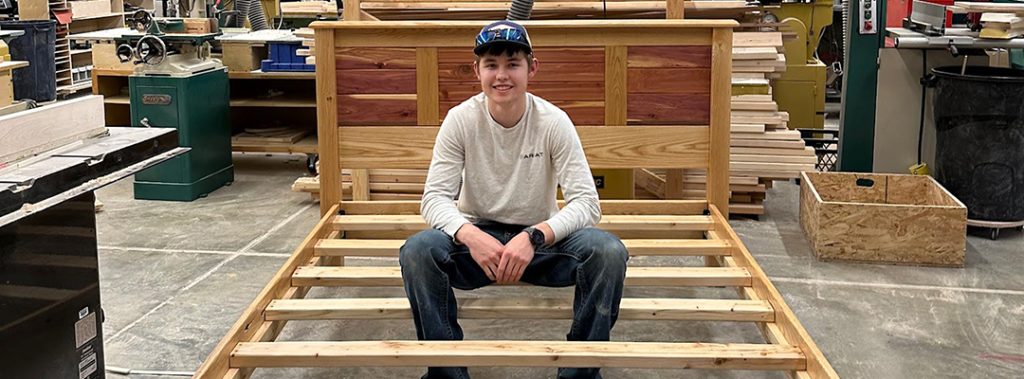
In 2014, Francis Carlson’s career took an unexpected turn. Though she had a certificate in fine woodworking from Selkirk College in Nelson, British Columbia, she struggled to find a job in the post-recession economy. It was then that Carlson, a 2011 Bonners Ferry High School (BFHS) graduate, discovered an opportunity to share her passion for woodworking in education.
Faced with the potential cut of the woodworking program at her alma mater due to the absence of a teacher, Carlson stepped in as a substitute teacher. Her initial reluctance turned into a genuine passion, and with enough experience on the job, she obtained a limited occupational specialist certificate and made the leap into teaching full-time.
“If we want our students to have the best education, we have to give them access to the best equipment,” Carlson affirmed. “Now I’m confident my students have that.”
Francis Carlson
Over the past nine years, Carlson has earned a bachelor’s degree in technical education and will finish a master’s degree in curriculum development from the University of Idaho. She has also become a fervent advocate for technical education and the imparting of practical employability skills.
“I’m passionate about CTE. I feel like this is where we should be directing our time, energy, and resources,” said Carlson.
Under Carlson’s guidance, the BFHS woodworking program has blossomed. Students start the program learning basics in shop safety, small tools and machines, as well as measuring and layout concepts. Students focus intensively on standards, planning, materials, drafting, and reading plans in their second year. The curriculum emphasizes lean manufacturing principles and includes techniques such as gluing and computer numerical control engraving for personalization. In their third year, students delve into the intricacies of cabinet joints, doors, and drawers, culminating in constructing cabinets for various locations at BFHS, such as classrooms, the principal’s office, and the shop toolroom. In the final year of cabinets, students dive deeper into cabinetry and fine woodworking learning advanced skills like veneering, glass etching, table construction and joints, with special emphasis on cabinet and furniture production.
Carlson actively collaborates with local employers to understand their needs, establish internships, and cultivate positive relationships with businesses. She also strives to give her students experience with industry-standard equipment so they can meet employers’ expectations on the job.
However, acquiring the necessary resources can be challenging in a small school within a small district. Though Carlson has made consistent upgrades and improvements since she began teaching, there’s one piece of equipment she hasn’t been able to replace: a dust collector originally installed in 1992. This vital component removes sawdust and woodchips, ensuring clean air and a safe work environment for students. The existing collector showed signs of wear and tear, but the financial burden of a $200,000 replacement was daunting for a small school.
Undeterred, Carlson used her grant-writing skills and applied for a Leading Idaho grant. In September 2023, she secured a $250,000 grant, not only covering the replacement of the dust collector but also upgrading the planer, drum sander, and jointer. The equipment is currently being manufactured, with the installation expected in January or February 2024.
Despite the temporary inconveniences during the installation, Carlson is optimistic about the new, more efficient equipment and how it will contribute to a dynamic and engaging educational experience. “If we want our students to have the best education, we have to give them access to the best equipment,” Carlson affirmed. “Now I’m confident my students have that.”
Diesel technology teacher bridges gap between industry and education
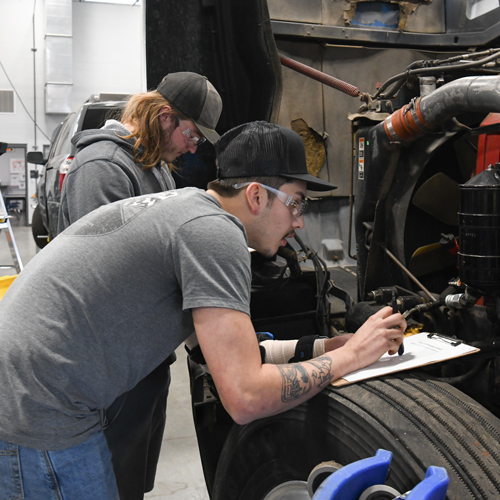

Paul Rood always liked cars, so it came as no surprise that after high school graduation in the late 1980s, he enrolled in Universal Technical Institute’s two-year auto diesel degree program and discovered his niche in heavy duty diesel repair.
“I never thought about being a diesel mechanic. Back then, it really wasn’t on my radar for a career,” said Rood. “But I took a diesel class for the heck of it and ended up really liking it.”
After 30 years working for top-tier employers like Peterbilt and Knife River, teaching was never on his radar. But somehow, towards the end of the COVID-19 pandemic, the CTE administrator at Kuna’s Swan Falls High School got a hold of his resume. The person who had been teaching diesel technology resigned unexpectedly, leaving a vacancy for a teacher with industry experience.
“All of my family and friends thought I’d be perfect for teaching, but I’d never really considered it until then,” said Rood. “When I went in for the interview, I was so impressed with the facility, I thought, ‘what the heck?’ and gave it a shot.”
I’m very tenacious, and what I envisioned when I took the job three years ago is pretty much where we’re at right now.
Paul Rood
Though Rood immediately took to the classroom and found students liked and respected him because of his experience, he found pursuing his Degree Based Career Technical Certificate through Idaho State University to fulfill the certification requirements was the most challenging part of his transition from industry veteran to educator.
“I don’t have a college background, so it was really frustrating to learn how to use software and technology platforms that I simply didn’t have to learn or use in the shop,” said Rood. “I think this is a glaring issue not only for me, but for other trades professionals trying to bring their experience to the classroom. Professors simply take for granted this gap in knowledge.”
Fortunately, Rood’s mentors from the Division, Bill Brown and Sandy Murin, helped him navigate the expectations of college-level work while simultaneously acclimating to being a new teacher.
“That first year was pretty challenging, but I always felt like Bill and Sandy were in my corner,” said Rood. “Bill especially helped me learn to play the game, and he’s talked me off the ledge more than once.”
In addition to his mentors, Rood also received strong support from the community and his technical advisory committee.
“Western States Cat, Knife River, Sun Rock, Western Trailer have all been so helpful since I’ve started this program. They donate parts and loan me equipment and give the kids opportunities like job shadowing, mentorship positions, and academies that lead to paid positions when they graduate,” said Rood. “I want my kids to aim high and feel comfortable rubbing elbows with people in prestigious shops. These partnerships really give them that.”
With only two classes left to complete his university coursework, Rood sees the light at the end of the tunnel.
“When I inherited this shop, it was just walls. I didn’t have any training aids or equipment to work on or any relationships with employers,” said Rood. “I’m very tenacious, and what I envisioned when I took the job three years ago is pretty much where we’re at right now.”
Integrated education training prepares student for rewarding career in trucking
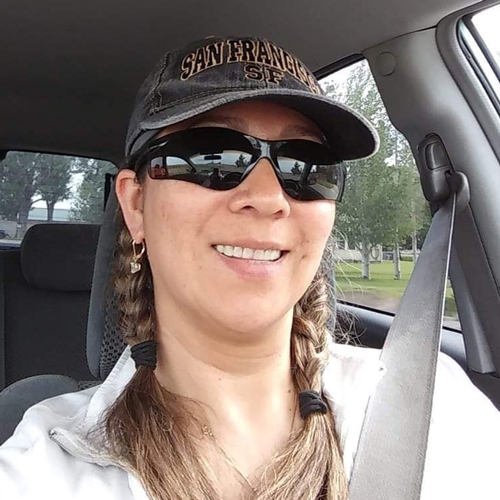
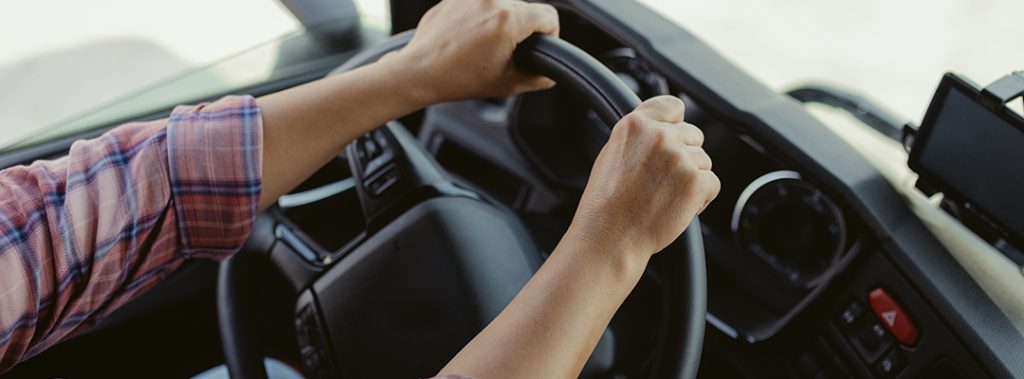
Since Sandra Cortes was a child, she wanted to drive big trailers. However, her mother believed it was a job suited only for men. So, Cortes put her dream aside and settled for driving 10-wheel trucks, water trucks, and tractors with trailers on a dairy farm in Jerome, Idaho. Everything changed when she learned about the College of Southern Idaho’s (CSI) commercial driver’s license program (CDLP).
In Idaho, aspiring commercial truck drivers need a commercial learner’s permit (CLP) to enroll in truck driving school. Getting this permit involves applying and taking a written test, but Cortes faced a language barrier that prevented her from meeting these requirements. However, CSI’s CDLP is part of its integrated educational training (IET) programs. This specialized adult education model tailors learning experiences to a particular profession, so students receive job-specific training while improving other basic skills like literacy and English language acquisition. It was a perfect fit for Cortes’ needs and interests.
“At CSI, our IET programs focus on careers in high demand for our region, such as welding or certified nursing assistant,” said Jennifer Hall, director of College and Career Readiness and adult basic education at CSI. “According to the Idaho Department of Labor’s August 2023 labor market report for South Central Idaho, heavy and tractor-trailer truck drivers were among the three occupations with the most job postings.”
When students enroll in the program, they’re assessed on their skills so support can be tailored to their current needs and abilities. The eight-week program includes learning job-specific skills like safety protocols, traffic laws, basic vehicle inspection, and general education skills such as vocabulary tailored to commercial truck driving.
“The CDLP program helped me understand there is more to driving than just getting on a trailer and moving forward. I use what I learned from this program every day; it’s changed the way I drive.”
Sandra Cortes
After completing the program, students earn their CLP and can enroll in one of CSI’s partner driving schools for their commercial driver’s license (CDL). After Cortes finished the intensive four-week driving course with an endorsement in doubles and triples, CSI extended job placement aid, leading her to her current role as a long-haul truck driver at Riverence, an Idaho-based sustainable aquaculture company.
Cortes is thrilled with her new career and deeply appreciates the support she received.
“I started with little experience, but they gave me a chance to learn,” Cortes said. “Riverence feels like my second school; landing this job has been an incredible experience.”
Rigby ag educator finds inspiration and influence through professional associations
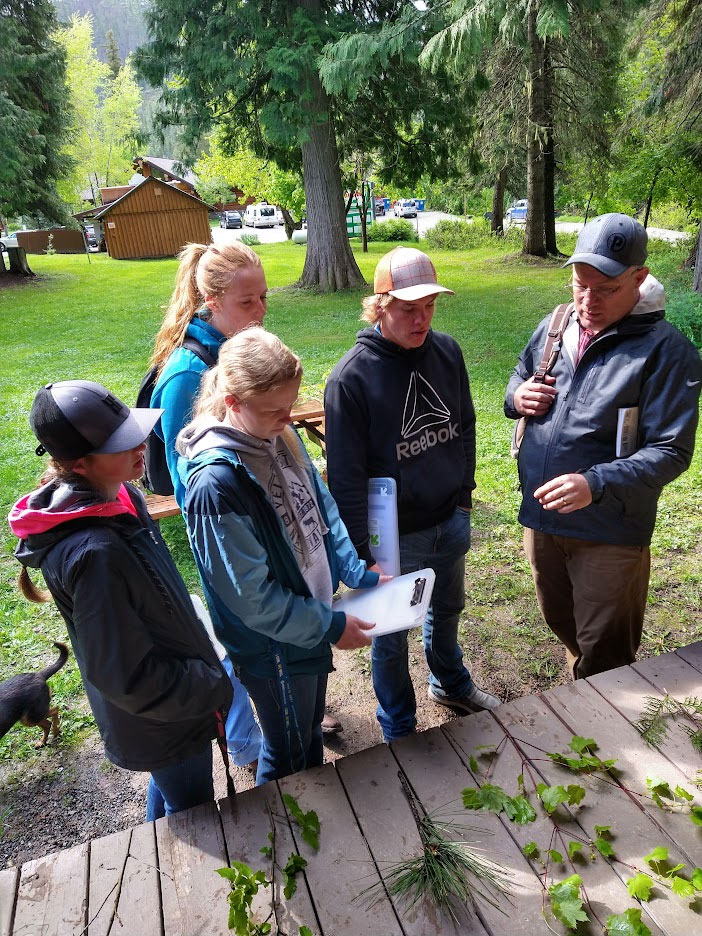
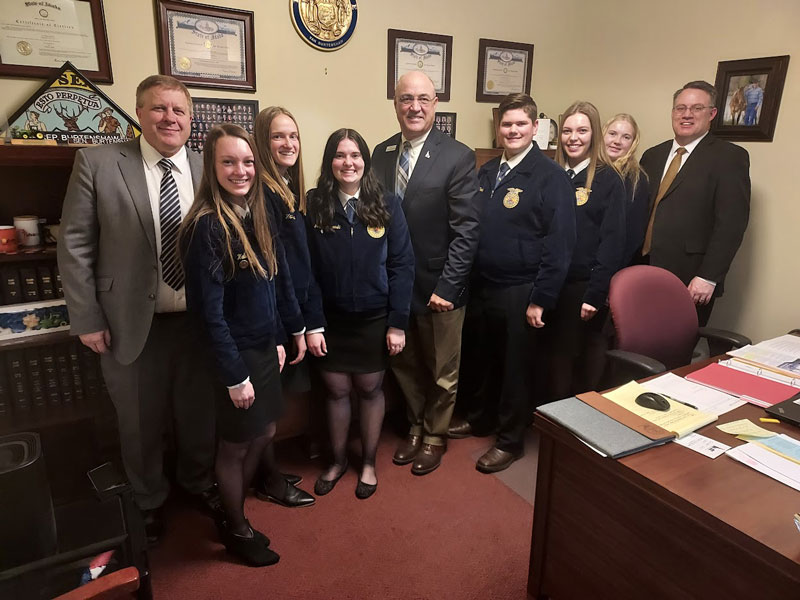
Lex Godfrey never set out to be a teacher. As a high school student in Utah, he was active in FFA. So, when he started college at Utah State University, he planned to get his degree in veterinary science. But when a trusted advisor suggested Godfrey become a teacher, he planted a seed that sprouted into a 24-year-long career.
After graduation in 1998, Godfrey accepted his first teaching job at Burley High School in Burley, Idaho. There, he met Gaylen Smyer, who would leave an indelible impression on Godfrey.
“I took over for Gaylen. He was a pillar of the community and ag education,” said Godfrey. “It was some awfully big shoes to fill. When he encouraged me to join the Idaho Agriculture Teachers Association (IATA) and the National Association of Agriculture Educators (NAAE), so I could connect with other educators, I took it to heart.”
As a new teacher, Godfrey immediately noticed the benefits of being involved with a professional association. Membership in IATA and NAAE included updates on legislation affecting agricultural education and CTE, resources for advocacy, access to awards and grants, and opportunities to hold leadership positions or join committees. In addition, it also provided plentiful opportunities to meet like-minded professionals.
“Teaching is a calling. Surrounding myself with other passionate educators was a fantastic way to share ideas and troubleshoot early in my career,” said Godfrey. “It was also a chance to network with more experienced educators.”
“Teaching is a calling. Surrounding myself with other passionate educators was a fantastic way to share ideas and troubleshoot early in my career. It was also a chance to network with more experienced educators.”
Lex Godfrey
In 2008, Godfrey’s colleague, Robert Hale, encouraged him to attend his first Career Technical Educators of Idaho (CTEI) meeting. Because he’d had such good experiences with IATA and NAAE, it didn’t take much convincing to attend. CTEI offered a state-specific perspective on CTE, plus access to educators in other pathways. Godfrey felt these new perspectives were just what he needed to develop his craft further. With ten years of teaching under his belt, Godfrey thought he was ready to share his passion with others and assume a leadership role. When the opportunity presented itself, Godfrey decided to run for CTEI President-Elect.

“When I was elected, I thought I’d have a year to shadow the current president and learn the ropes,” said Godfrey. “But she had to step down in the middle of her term, so I became president after about six months.”
Holding a leadership position early in his career accelerated Godfrey’s professional development.
“I soon discovered that, regardless of the pathway, we were all experiencing the same things,” said Godfrey. “Connecting with educators in other areas deepened my knowledge and gave me new insights into teaching and serving my students.”
Though not all educators will choose to pursue leadership positions in their professional associations, Godfrey encourages all educators to become active in their pathway-specific professional associations and CTEI. He has some specific advice for new and seasoned educators alike.
“For new teachers, professional associations are a great way to find a mentor who resonates with you. Especially early in your career, it’s important to find someone to bounce ideas off and support you,” said Godfrey. “And for seasoned educators, professional associations are an opportunity to invest in other professionals and share some of what you’ve acquired over the years.”
Godfrey has taught at Rigby High School since 2016 and has remained active in IATA, NAAE, and CTEI. In addition, he was one of the inaugural members of IDCTE’s statewide CTE Advisory Council, which is comprised of educators, administrators, and elected officials with a vested interest in Idaho’s CTE programs.
“Just having a seat at the table has made a huge difference in my career,” said Godfrey. “It means a lot whenever a colleague, legislator, or elected official calls to ask me what I think. My experience with professional associations has given me influence, and I’ve been able to use that to make an impact.”
Medical assisting program helps fill growing demand for healthcare professionals

In 2019, School District 25 Career Technical Administrator for Pocatello’s Gateway Professional Technical Education program Rhonda Naftz recognized that many students interested in health professions didn’t want to pursue a career in nursing. Naftz researched potential programs to meet her students’ interests. She discovered that medical assistants (MA) do many routine administrative and clinical functions, creating additional time for doctors and nurses to care for their patients. The labor market data showed and still reports a dire need for health professionals nationwide, resulting in high demand for Medical Assistants in hospitals, clinics, and doctor offices.
Naftz approached the Division about piloting the state’s first secondary MA program. Naftz knew the program needed an instructor with both practical and classroom experience to succeed. She found that instructor in Kristina Pasquella. A graduate from Idaho State University’s MA program, Pasquella was working full-time in a local medical facility and also adjunct faculty in the ISU MA program.
“Our program creates an amazing pipeline into medical assisting or other healthcare classes.”
Kristina Pasquella

“I’d piloted quite a few education programs for mental health and healthy living programs in the past. As a kid, I always wanted to be a teacher, so creating the pilot program was really interesting and appealed to me,” said Pasquella.
Given Pasquella’s decade of experience as an MA, she worked with ISU and the State CTE Division to design a program giving students the real-world experiences they’d need to be successful. Her classroom looks like an actual medical clinic, complete with exam rooms and a waiting room stocked with posters and brochures created by her students. Students practice calling a patient from the waiting room, walking them to an exam room, taking vitals, asking questions, and recording the answers for the doctor to review. They also get to practice giving intradermal, intramuscular, and transdermal injections on an injection pad. One of their favorite activities is practicing drawing fake blood from realistic-looking silicone arms. Though students enjoy the clinical aspects of the program, they also learn clerical and administrative tasks like scheduling appointments, billing patients and insurance, and medical coding.

“Our program creates an amazing pipeline into medical assisting or other healthcare classes,” said Pasquella.
The partnership with ISU allows students to take to earn college credits for five of the six classes using Advanced Opportunities funds, meaning students pay nothing out of pocket, and their credits transfer seamlessly after graduation. About a quarter of the students who complete the program go right to work after graduation; others can go to CSI to earn a certificate or ISU to pursue a two-year degree.
Four years after its inception, 113 students have completed the program, with 43 more scheduled for this year. Interest in the program—from students and regional employers—continues to grow. Moving forward, Naftz says they’re planning on consolidating all the health profession programs into one building to better use resources and equipment and investigating adding a Certified Clinical Medical Assistant credential to the program.
“Medical programs are notoriously expensive to run, but there’s nothing like CTE to show real, tangible results and a direct correlation between investment and student success,” said Naftz. “We’re so grateful for the continued support of the Pocatello Chubbuck School District, the Division, and the legislature for this and all our CTE programs.”
Senior discovers passion and purpose through CTSOs


When current Joint Student Leadership (JSL) President Cree Milliron was a freshman at Burley High School, becoming a leader wasn’t on his radar. He’d never heard of career technical student organizations (CTSOs) in general or Business Professionals of America (BPA) in particular. He knew he loved graphic design, though, so when his web design teacher, Janet Cole, who also served as his school’s BPA advisor, encouraged him to join to show off the skills he’d acquired in her class, he jumped in with both feet and ran for chapter officer.
Though he didn’t get the position, he stuck with BPA and discovered he loved the competitions and meeting other students with the same interests as him from across the state.
“Competitions gave me the opportunity and confidence to bring my ideas to life,” said Milliron. “It was also overwhelming to see how many other students had the same interests and values as me.”
“Being involved with BPA has done so much for me. I wanted to inspire new members to see the value in joining, too.”
CREE MILLIRON
His first year was such a positive experience that Milliron ran for chapter officer again during his sophomore year and was elected chapter president. Though planning and running meetings were valuable foundations for his burgeoning leadership skills, Milliron discovered his real purpose was working with other members and sharing his passion and experience with them.
“Being involved with BPA has done so much for me,” said Milliron. “I wanted to inspire new members to see the value in joining, too.”
After two years, Milliron decided to take on more responsibility and became a State Officer. In this elevated role, he had more opportunities to interact with BPA members from across the state and get more involved with staff at the Idaho Division of Career Technical Education. Plus, he had the opportunity to meet State Officers from other CTSOs.
“When I first joined BPA, I had no idea what it was, much less that there were other CTSOs for other career pathways,” said Milliron. “Serving as a State Officer let me see that we have so much in common. We were all passionate about advocating for our organization and giving other students somewhere to belong, no matter what they’re interested in.”
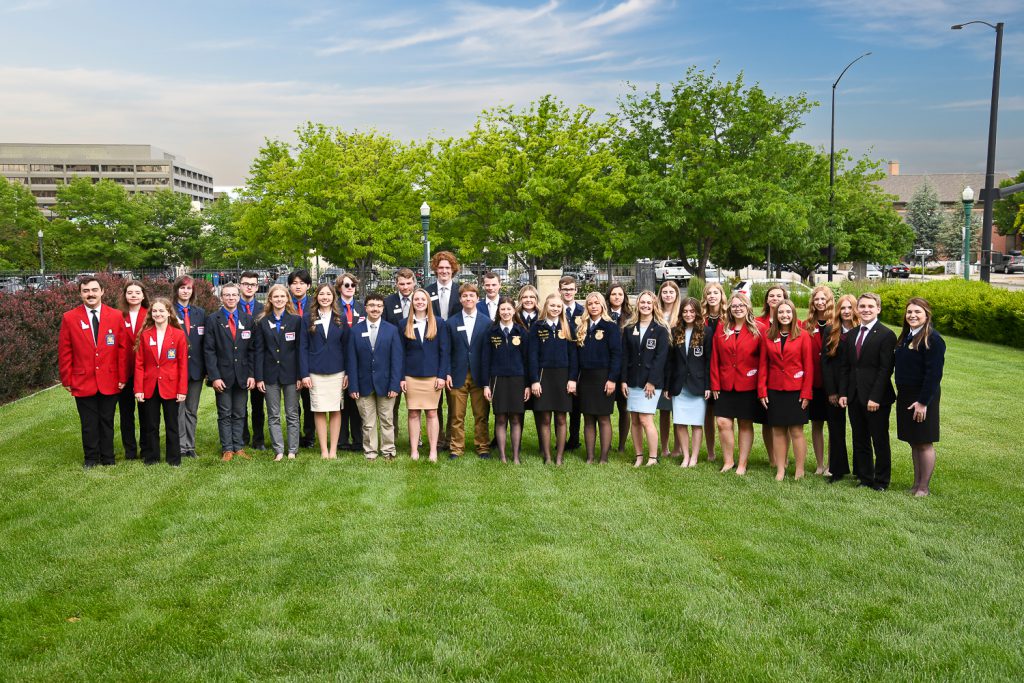
Now a senior, Milliron has continued to grow and develop as a leader and competed in two BPA National Leadership Conferences. In 2021, Milliron placed third in Promotional Photography, and his team placed seventh in Web Design. He also earned third place in Graphic Design Promotion at the 2022 State Leadership Conference.
His increasing responsibility and experiences in state and national competitions improved his leadership and communication skills and his self-confidence.
“I’ve watched myself come to life over the last four years. People always told me I was a good leader, but now I’ve had some experiences to prove that was true,” said Milliron.
Milliron is still deciding what to do after graduating, but he knows that whatever path he chooses, his experiences with CTSOs in high school will give him the skills and confidence to succeed.
“When I first joined, it was daunting to run for office or sign up for a competition. I had so many self-doubts,” said Milliron. “I remember thinking, ‘You can’t run for office; you don’t have any experience,’ or ‘You can’t win this competition; you just joined.’ But CTSOs aren’t designed for people who already know what they’re doing. They’re for people trying to figure out what they’re good at and passionate about.”
Innovative program exposes underserved students to CTE
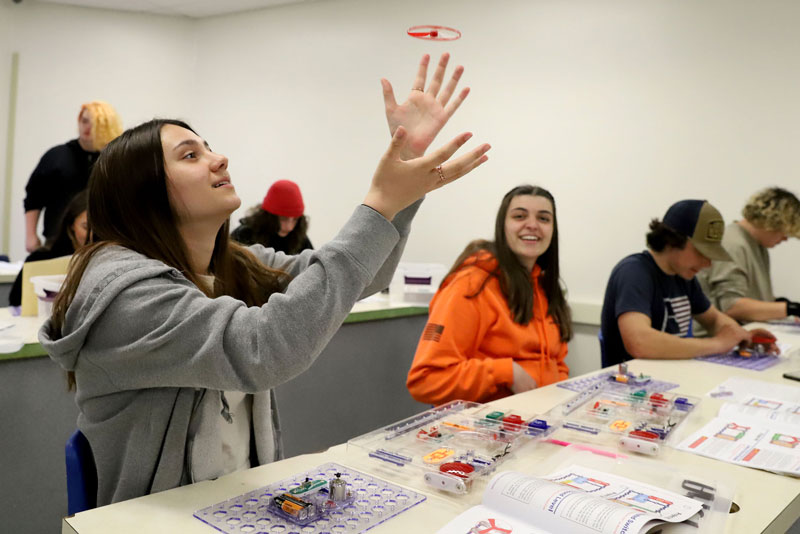
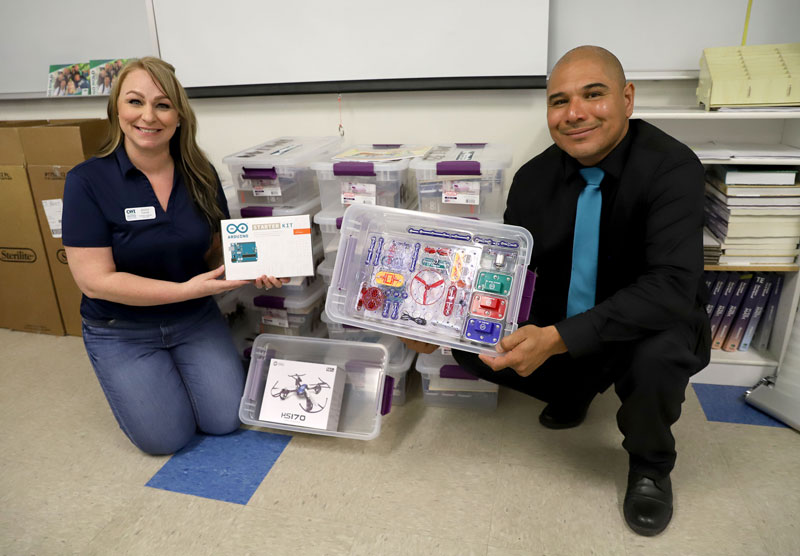
Jessica Concie and Oster Hernandez, transition coordinators for the College of Western Idaho’s (CWI) Dual Credit department, have long believed in the power of CTE. So, when Concie discovered CWI’s Center for New Directions had assembled a plastic trunk filled with a lesson plan and some hands-on activities using an included circuit board to introduce students to CWI’s Mechatronics program, she thought it would be a perfect way to spark the interest of students enrolled at alternative high schools in the Treasure Valley.
“Oster and I have a soft spot for these kids because they’re so often overlooked. A lot of them are just trying to get through high school; they’re not thinking about what’s next or what could be,” said Concie. “CTE programs tend to work really well for these students because they’re so hands-on, and students can clearly see how what they learn connects to careers.”
With the support and approval of their supervisor, Concie and Hernandez created the Pop the Trunk initiative. To expose these students to some of the 41 CTE programs offered at CWI, Concie and Hernandez approached CTE faculty about creating a week’s worth of lesson plans to introduce potential students to their CTE program. The lesson plans would be accompanied by trunks—one per student—filled with equipment and activities to support the lessons. Materials were purchased using grant money, and the program is available at no cost to students or teachers.
“CTE programs tend to work really well for these students because they’re so hands-on, and students can clearly see how what they learn connects to careers.”
Jessica Concie

Pop the Trunk launched during the 2021-2022 school year with three programs: Mechatronics, Unmanned Aerial Systems, and Drafting. Concie and Hernandez reached out to alternative high schools throughout the Treasure Valley to let them know the program was available.
“We sent out emails to see who was interested, then we dropped off a trunk with the teacher so they could see the lesson plans and play with the trunks. If they liked what they saw, we’d deliver the trunks so they could use them with their students,” said Hernandez.
Teachers and students at Meridian Academy in Meridian, Initial Point High School in Kuna, Eagle Academy in Eagle, and Middleton Academy in Middleton liked what they saw. Now in its second semester, Pop the Trunk continues to grow in scope and popularity. Additional trunks for Automotive Technology, Diesel, and Welding are being developed, and CTE faculty who help develop the trunks and the teachers at the alternative high schools will receive a $500 stipend for their help in developing and using the program starting the spring 2023 semester. In addition, other technical colleges, such as the College of Southern Idaho, have reached out to mirror the program elsewhere in the state.
“It’s been hugely successful because it allows students without access to a lot of resources or support to see what’s possible,” said Hernandez. “We’re looking at expanding the program to rural schools, too.”
Long term, Concie and Hernandez would love to see technical colleges nationwide create their own Pop the Trunk programs to help underserved and overlooked student populations discover CTE. In fact, they were accepted to give a presentation on the initiative at the ACTE Vision Conference in Las Vegas in December 2022.
“I hope schools in other states see the program is working. If we can do it in Idaho, we can do it anywhere,” said Concie. “This is a fantastic way to expose students to what CTE is all about who otherwise wouldn’t have that opportunity.”
 Official Government Website
Official Government Website